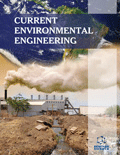[3]
Mussatto SI, Machado EMS, Martins S, Teixeira JA. Production, composition, and application of coffee and its industrial residues. Food Bioprocess Technol 2011; 4: 661-72.
[4]
Esquivel P, Jiménez VM. Functional properties of coffee and coffee by-products. Food Res Int 2012; 46: 488-95.
[6]
Devi R, Singh V, Kumar A. COD and BOD reduction from coffee processing wastewater using Avacado peel carbón. Bioresour Technol 2008; 99: 1853-60.
[7]
Rodríguez S, Pérez RM, Fernández M. Estudio de la biodegradabilidad anaerobia de las aguas residuales del beneficio húmedo del café. Interciencia 2000; 25: 386-90.
[8]
Cruz-Salomón A, Ríos-Valdovinos E, Pola-Albores F, Lagunas-Rivera S, Meza-Gordillo R, Ruíz-Valdiviezo VM. Evaluation of hydraulic retention time on treatment of Coffee Processing Wastewater (CPWW) in EGSB bioreactor. Sustainability 2018; 10(1): 83.
[9]
Cruz-Salomón A, Ríos-Valdovinos E, Pola-Albores F, Meza-Gordillo R, Lagunas-Rivera S, Ruíz-Valdiviezo VM. Anaerobic treatment of agro-industrial wastewater for COD removal in expanded granular sludge bed bioreactor. Biofuel Res J 2017; 16: 715-20.
[10]
Siu Y, Mejia G, Mejia-Saavedra J, Pohlan J, Sokolov M. Heavy metals in wet method coffee processing wastewater in Soconusco, Chiapas, Mexico. Bull Environ Contam Toxicol 2007; 78: 400-4.
[11]
Rossmann M, Teixeira de Matos A, Carneiro AE, Fonseca e Silva F, Carraro-Borges A. Performance of constructed wetlands in the treatment of aerated coffee processing wastewater: Removal of nutrients and phenolic compounds. Ecol Eng 2012; 49: 264-9.
[12]
Cruz-Salomón A. Design and evaluation of EGSB bioreactors for the treatment of agro-industrial wastewaters of the state of Chiapas Doctoral Thesis. UNICACH, Chiapas, Mexico, 2018.
[14]
Bello-Mendoza R, Castillo-Rivera MF. Start-up of an anaerobic hybrid UASB filter reactor treating wastewater from a coffee processing plant. J Anaerobe Environ Microbiol 1998; 4: 219-25.
[15]
Haddis A, Devi R. Effect of effluent generated from coffee processing plant on the water bodies and human health in its vicinity. J Hazard Mater 2008; 152: 259-62.
[16]
Wang J, Huang Y, Zhao X. Performance and characteristics of an anaerobic baffled reactor. Bioresour Technol 2004; 93: 205-8.
[17]
Peng JW, Cui Y, Jiang X, Dong K. Start-up on divisional influent of highly effective anaerobic baffled reactor. Environ Sci Technol 2008; 31(11): 28-30.
[18]
Roshayu-Hassan S, Irvan DI. Anaerobic wastewater treatment using anaerobic baffled bioreactor: A review. Cent Eur J Eng 2013; 3(3): 389-99.
[19]
American Public Health Association (APHA). Standard Methods for the Examination of Water and Wastewater 20th ed.; American Public Health Association/ American Water Works Association/Water Environment Federation: Washington, DC, USA, 2005.
[20]
Tacias-Pascacio VG. Design, construction and evaluation of a reactor of flow piston coupled to membrane, for coffee processing wastewater Master's Thesis. ITTG. Chiapas, Mexico. 2012.
[21]
Yemane DT, Beyene AH, Addis TW, Gebresilassie AT. Effect of coffee processing plant effluent on the physicochemical properties of receiving water bodies, Jimma Zone Ethiopia. Am J Environ Prot 2015; 4: 83-90.
[22]
Selvamurugan M, Doraisamy P, Maheswari M, Nandakumar NB. High rate anaerobic treatment of coffee processing wastewater using upflow anaerobic hybrid reactor. Iran J Environ Health Sci Eng 2010; 7: 129-36.
[23]
Hue NV, Bittenbender HC, Ortiz-Escober ME. Managing coffee processing water in Hawaii. J Hawaii Pac Agric 2006; 13: 15-21.
[24]
Shanmukhappa DR, Ananda ARP, Srinivasan CS. Water pollution by coffee processing units and its abatement. Indian Coffee 1998; 10: 3-9.
[25]
Neves L, Oliveira R, Alves M. Anaerobic co-digestion of coffee waste and sewage sludge. Waste Manag 2006; 26: 176-81.
[26]
von Enden JC, Calvert KC. Review of coffee wastewater characteristics and approaches to treatment PPP Project, Improvement of Coffee Quality and Sustainability of Coffee Production in Vietnam” German Technical Cooperation Agency. GTZ 2010.
[27]
Fang HHP, Chui HK. Maximum COD loading capacity in UASB reactors at 37°C. J Environ Eng 1993; 119(1): 103-99.
[28]
Cruz-Salomón A, Meza-Gordillo R, Lagunas-Rivera S, Ventura-Canseco C. Biogas production potential from native beverage Vinasse of Mexico. Water Technol 2017; 5: 9-14.
[29]
Ramos-Vaquerizo F, Cruz-Salomón A, Ríos-Valdovinos E, et al. Anaerobic treatment of vinasse from sugarcane ethanol production in expanded granular sludge bed bioreactor. J Chem Eng Process Technol 2018; 9: 1.
[30]
Muro C, Escobar R, Zavala M, et al. Evaluación del proceso de microfiltración en un efluente residual de una industria alimenticia para su reuso. Rev Int Contam Ambient 2009; 25(4): 229-38.
[31]
Cruz-Salomón A, Meza-Gordillo R, Rosales-Quintero A, Ventura-Canseco C, Lagunas-Rivera S, Carrasco-Cervantes J. Biogas production from a native beverage vinasse using a modified UASB bioreactor. Fuel 2017; 198: 170-4.
[32]
Official Mexican Environmental Regulations 1996 NOM-001- SEMARNAT, Comisión Nacional del Agua 2015.
[33]
Guideline for Discharge of Industrial Effluent Characteristics. WHO: Geneva, Switzerland 1995; 3: 231- 6.
 26
26 6
6

